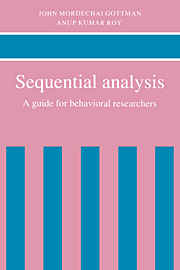Book contents
- Frontmatter
- Contents
- Preface
- Reading this book quickly
- Part I Introduction
- Part II Fitting the timetable
- Chapter 4 The order of the Markov chain
- Chapter 5 Stationarity of the Markov chain
- Chapter 6 Homogeneity
- Chapter 7 Everyday computations of stationarity, order and homogeneity
- Chapter 8 Sampling distributions
- Chapter 9 Lag sequential analysis
- Part III The timetable and the contextual design
- References
- Index
Chapter 7 - Everyday computations of stationarity, order and homogeneity
from Part II - Fitting the timetable
Published online by Cambridge University Press: 10 November 2009
- Frontmatter
- Contents
- Preface
- Reading this book quickly
- Part I Introduction
- Part II Fitting the timetable
- Chapter 4 The order of the Markov chain
- Chapter 5 Stationarity of the Markov chain
- Chapter 6 Homogeneity
- Chapter 7 Everyday computations of stationarity, order and homogeneity
- Chapter 8 Sampling distributions
- Chapter 9 Lag sequential analysis
- Part III The timetable and the contextual design
- References
- Index
Summary
The Arundale Programs
Arundale (1982) wrote two useful programs for Markov analysis, called SAMPLE and TEST. The program SAMPLE takes as input a sequence of as many as 3,000 observations of up to 15 different discrete states. It outputs transition frequency and transition probability matrices for the input sequence. SAMPLE also tests the stationarity of the sequence (user specifies the number of chunks to break the original data set into) and it also tests order. The program TEST takes as input a set of transition frequency matrices and compares pairs of these matrix sets by specifying one set as the expected values and one set as the observed values. Both Pearson and likelihood ratio statistics are computed. It is possible to average a set of the input matrices before testing, or to test a group of matrices for homogeneity. The Arundale programs are also now available for an IBM-compatible personal computer.
Example
The data in this chapter come from a study, conducted by Krokoff, Gottman, and Roy (1988), of 120 married couples in a random sample study of blue- and white-collar couples who were either happily or unhappily married. Fifty-two of the home audiotapes of these couples attempting to resolve an existing marital issue were coded using the Couples Interaction Scoring System (see Gottman, 1979a). In the present context we examine only the affect portion of these codes, of which there are six: (1) husband positive (H+); (2) husband neutral (HO); (3) husband negative (H–); (4) wife positive (W+); wife neutral (WO); and, (6) wife negative (W–).
- Type
- Chapter
- Information
- Sequential AnalysisA Guide for Behavorial Researchers, pp. 77 - 84Publisher: Cambridge University PressPrint publication year: 1990



